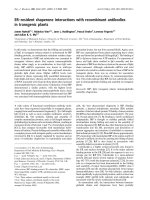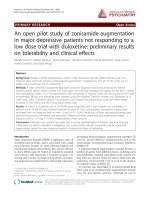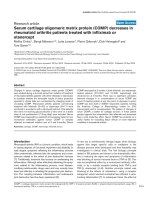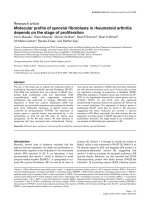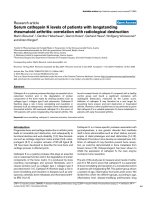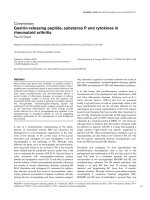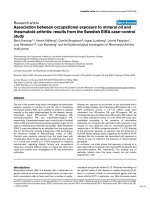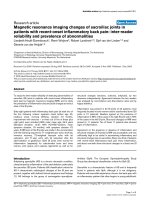Báo cáo y học: "Slit3 inhibits Robo3-induced invasion of synovial fibroblasts in rheumatoid arthritis" potx
Bạn đang xem bản rút gọn của tài liệu. Xem và tải ngay bản đầy đủ của tài liệu tại đây (577.51 KB, 9 trang )
RESEARC H ARTIC L E Open Access
Slit3 inhibits Robo3-induced invasion of synovial
fibroblasts in rheumatoid arthritis
Alexandra E Denk
1
, Simone Kaufmann
1
, Klaus Stark
2
, Jörg Schedel
3
, Torsten Lowin
3
, Thomas Schubert
1
,
Anja K Bosserhoff
1*
Abstract
Introduction: The repellent factor family of Slit molecules has been described to have repulsive function in the
developing nervous system on growing axons expressing the Robo receptors. However, until today no data are
available on whether these repellent factors are involved in the regulation of synovial fibroblast (SF) activity in
rheumatoid arthritis (RA).
Methods: mRNA expression in primary synovial fibroblasts was quantified by quantitative reverse transcription PCR
and protein expression was measured by fluorescence activated cell sorting (FACS) analysis. Different functional
assays were performed with rheumatoid arthritis synovial fibroblasts (RASF): proliferation, migration and a novel in-
vitro cartilage destruction assay.
Results: First, we found increased expression of Robo3 expression in RASF compared to normal SF. Interestingly,
analysis of data from a recently published genome-wide association study suggests a contribution of ROBO3 gene
polymorphisms to susceptibility of RA. Functional assays performed with RASF revealed induction of migration and
cartilage destruction by Robo3 and increased matrix metalloproteinase (MMP)1 and MMP3 expression. Treatment of
RASF in early passages with Slit3 led to inhibition of migration whereas RASF in later passages, having reduced
Robo3 expression in cell culture, were not inhibited by Slit3 treatment. Here, reduction of Robo3 expression from
passage 3 to 10 might reflect an important step in losing repulsive activity of Slit3.
Conclusions: Taken together, our data showed that deregulation of the Robo3 receptor in synovial fibroblasts in
RA correlates with aggressiveness of the fibroblasts. Slit3 reduces the migratory activity of synovial cells from
patients with RA, potentially by repulsion of the cells in analogy to the neuronal system. Further stud ies will be
necessary to prove Slit activity in vivo.
Introduction
A s trict separation of compartments is essential to
ensure the correct mechanical function of the joint.
Alterations at the joint compartment boundaries are fre-
quently found in inflammatory or degenerative joint dis-
eases such as rheumatoid arthritis (RA). The destruction
of articular structures of the joint, such as cartilage and
bone, through synovial fibroblasts (SF) is a crucia l event
especially in RA [1,2].
The chronic autoimmune disease RA is of unknown
origin but finally leads to joint destruction [1]. The so-
called ‘tumour-like’ or ‘activated’ SF are localized in the
hyperplastic synovium of patients with RA. Supported
by adhesion molecule s, these rheumatoi d arthritis syno-
vial fibroblasts (RASF) attach to cartilage, where matrix-
degrading enzymes release d by RASF finally cause the
destruction of the joint [3].
As loss of integrity of compartment borders in the
joint b etween cartilage and SF is a key event in RA, we
were interested in analyzing molecular cues, such as the
repellentfactors,thatmightbederegulatedinRA
patients and thereby contribute to destruction of joint
borders.
Repellent factors of the Roundabout (Robo)- and Slit-
family are primarily known to be involved in regulating
cell-cell interactions and cell-matrix interactions of
migrating cells during embryonic developme nt [4] and
by mediating axon guidance through attraction or
* Correspondence:
1
Institute of Pathology, University of Regensburg, Franz-Josef-Strauss-Allee
11, 93053 Regensburg, Germany
Denk et al. Arthritis Research & Therapy 2010, 12:R45
/>© 2010 D enk et al.; licen see BioMed Central Ltd. This is an open access article distributed under the terms of the Creative Commons
Attribution License ( whi ch permi ts unrestricted use, distribution, and reproduction in
any medium, provided the original work is pro perly cited.
repulsion of growth cones [5-7]. Over the past decade,
the Robo-/Slit-system has also been described to me d-
iate cell adhesion of fibroblasts [8] and to induce tumor
angiogenesis [6].
There are four human Robo transmembrane receptors
(Robo1, Robo2, Robo3, and Robo4) that share fibronec-
tin type III and immunoglobulin (Ig)-like d omains, but
vary in their cytoplasmatic domains. The ligands for the
Robo receptors are the secreted Slit molecules (Slit1,
Slit2 and Slit3) consisting of four leucine-rich repeat
domains (D1 to D4), seven to nine epidermal growth
factor-like domains, a laminin G domain, and a C-term-
inal cysteine-rich domain [5]. Slit binding to Robo
receptors is mediated by the second of the four highly
conserved leucine-rich repeat domains of the ligand Slit
and the first extracellular Ig domain of the Robo recep-
tor [9-11].
In our study, we first analyzed the expression of
Robo1, Robo2, Robo3, Slit1, Slit2, and Slit3 in the SF of
patients with RA and continued to evaluate the influ-
ence of Robo3 expression and effects of S lit3 on RASF
as a potential therapeutic tool.
Materials and methods
Primary fibroblasts
Synovial tissue samples were obtained from syn ovect-
omy and arthroplastic surgery from patients with RA
(RASF) or from trauma surgery patients (normal SF)
after informed consent and approval of the local ethics
committee. All RA patients fulfilled the American Col-
lege of Rheumatology 1987 criteria for the diagnosis of
RA. In RA patients, materia l was sampled from the
wrist o r proximal interphalangeal joints with the joints
exhibiting florid synovitis and/or arthritic destructions.
Normal SF deriving from normal synovial tissue was
taken from knee joints of two patients within two to
four hours after knee injury. Both patients underwent
surgery because of displaced tibial plateau fractures.
Synovial tissue was minced mechanically, washed exten-
sively in sterile PBS and digested with 150 mg/ml Dis-
pase II (Boehringer Mannheim, Mannheim, Germany)
for one hour at 37°C under continuous agitation. The
resulting cell suspension was seeded into tissue culture
dishes and cultured in DMEM (Gibco Life Technologies,
Basel, Switzerland) containing 10% FCS and 100 U/ml
penicillin per 100 μg/ml streptomycin in a humidified
atmosphere at 37°C followed by the addition of 5% car-
bon dioxide. In different passages, adhering fibroblasts
were washed, trypsinized, and used for RNA isolation or
in the assays.
Normal dermal fibroblasts were obtained and used as
described previously [12].
The number of donors used in each experiment is
given in each figure legend.
Transient transfection
Primary fibroblasts wer e transfected using the Amaxa
Nucleofector System (Amaxa, GmbH, Cologne, Ger-
many) with the Amaxa Normal Human Dermal Fibro-
blast Nucleofector® Kit according to the manufacturer’s
instructions (program: U23) [13]. The transfection effi-
ciency was about 30%, toxicity was 20%.
For analysing Robo3 effects, synovial cells in late pas-
sages (P5 and P6) or dermal fibroblasts were transi-
ently transfected with mouse Robo3 expression
construct, which was a gift from Shyng-Shiou Yuan
[14]. Vector pCMX [13] was used as control. Transfec-
tion efficiency was quantified by quantitative real-time
(RT)-PCR.
Genetic association study
Genome-wide data from a recently published screen for
polymorphisms associated with RA were employed to
survey the complete ROBO3 gene region in silico [15].
All successfully genotyped SNPs on the Affymetrix Gen-
eChip® Human M apping 500K Array Set (Santa clara,
CA, USA) on chromosome 11 in the ROBO3 region
with approximately 40 kb on either side of the gene
(position 124,200,001 and 124,300,000; human genome
build 18) were included. Wellcome Trust Case Control
Consortium (WTCCC) data were accessed on by 26
June 2007 [15,16]. Data of t he HapMap phase II release
22 data were used to assess linkage disequilibrium pat-
terns of the ROBO3 gene region [17].
RNA isolation and reverse transcription
Total cellular RNA was isolated from cultured cells
using the RNeasy kit (QIAGEN , Hilden, Germany) and
cDNAs were generated by reverse transcri ptase reaction
as described previously [18].
Quantitative RT-PCR
Quantitative RT-PCR was performed on a LightCycler
(Roche, Mannheim, Germany) using 10 μlN’ ,N’ -
dimethyl-N-[4-[(E)-(3-methyl-1,3-benzothiazol-2-yli-
dene)methyl]-1-phenylquinolin-1-ium-2-yl]-N-propyl-
propane-1,3-diamine (SYBR) MIX (TaKaRa, Shiga,
Japan), 0.5 μl(20μM) of forward and reverse primers
and 1 or 2 μl cDNA template in a total of 20 μl. cDNA
fragments of Robo1, Robo2, Robo3, Slit1, Slit2, and Slit3
in S F in early passages (P3 and P4) wer e amplified
according to the following PCR program: 30 seconds at
95°C (initial denaturation); 20°C/second temperature
transition rate up to 95°C for 5 seconds, 10 seconds at
55°C (Robo1, Robo2, Slit2)/56°C (Slit1, Slit3)/58°C
(Robo3), 15 seconds at 72°C, 10 seconds at 82°C
(Robo1, Robo2, Slit2)/86°C (Slit1, Slit 3)/85°C (Robo3)
acquisition mode single, repeated for 40 times
(amplification).
Denk et al. Arthritis Research & Therapy 2010, 12:R45
/>Page 2 of 9
Matrix metalloproteinase (MMP)-1 and MMP-3 quan-
titative RT-PC R was performed 48 hours after transfec-
tion at 95°C for 5 seconds, 3 seconds at 68°C (MMP-1)
or 62°C (MMP-3), 10 seconds at 72°C and 8 seconds at
82°C (MMP-1) or 82°C (MMP-3) acqu isition mode sin-
gle. Annealing temperature was optimized for each pri-
mer set and the PCR reaction was evaluated by melting
curve analysis following the manufacturer’s instructions
and checked by electrophoresis. B eta-actin mRNA was
amplified to ensure cDNA integrity and to normalize
expression. Each quantitative PCR was performed at
least in duplicate for two sets of RNA preparations.
The following primers were used: Robo1 (for: AGG
AAG AAG ACG AAG CCG AC, rev: CGA AGA ACT
AAC ACT GGA GCG), Robo2 (for: GAG ACC TCA
CAA TCA CCA ACA TTC AAC, rev: CAG TAA CGC
TGT ACC ATC CAC TGC), Robo3 (for:
GCGCTTCTCAGTGTCTCCAAG, rev: TGGTCCCTG
GAGGATGACA), Slit1 (for: ACT CGC TGG TCC TCT
ATG GAA, rev: CGC AAA TGA AAG GGT TCT
GGG), Slit2 (for: TGC CTT TGC CCA CCT GAG TA,
rev:TGTCGCAGTGTTCACCTACG),Slit3(for:
TGA TGG CAA CGA GGA GAG TA, rev: ACG GCT
GTT AGG TGG TTT CC) MMP1 (for: TGG ACC
AAG GTC TCT GAG GGT CAA, rev: GGA TGC CAT
CAA TGT CAT CCT GA) and MMP3 (for: GGC ACA
ATA TGG GCA CTT TAA ATG AAG C, rev: GTC
TAC ACA GAT ACA GTC ACT TGT CTG).
Cell proliferation assay
Proliferation was measured using the Cell Proliferati on
Kit II (Roche,, Mannheim, Germany) acc ording to the
supplier’ s instructions. It is based on a colorimetric
(XTT) measured non-radioactive quantification of cell
proliferation performed for four days. RASF in passage 3
and 4 were treated with recombinant mouse Slit3 (R&D
Systems, Minneapolis, MN, USA) in a concentration of
0.1 μg/ml. Experiments were repeated at least twice.
Migration assay
Migration assay were performed using Boyden Cham-
bers containing polycarbonate filters with 8 μmpore
size (Costar, Bodenheim, Germany), as described pre-
viously [18]. Briefly, filters were coated with gelatin. The
lower compartment was filled with fibroblast-condi-
tioned medium, used as a chemo-attractant. Synovial
cells in early passages (P3 and P4) and in late passages
(P5 and P6; as indicated) were harvested with trypsin
incubation for two minutes, resuspended in DMEM
without FCS at a density of 3 × 10
4
cells/ml and
injected in the upper compartment of the chamber on
the filter. A fter incubation at 37°C for four hours, all
cells attached to the upper surface of the membrane
were removed. Cells adhering to the lower surface were
fixed, stained a nd counted. Recombinant mouse Slit3
(R&D Systems, Minneapolis, MN, USA) was added
either to the upper or the lower chamber of the system
in a concentration of 0.1 μg/ml. All experiments were
performed in triplicates and repeated at least twice.
Cartilage destruction assay
Cartilage was obtained from donors after informed con-
sent and approval of the local ethics committee. Normal
cartilage with no significan t softening or surface fibrilla-
tion was obtained at autopsy within 48 h after death.
Cartilage was ke pt at -80°C before use. SF (50,000 cells
per a ttempt ) in early passages (P3 and P4) and synovial
cells in late passages (P5 and P6) or dermal f ibroblasts
with Robo3 transfection (as indicated) were incubated
with pieces of cartilage (8 pieces of 2 mm
3
(50 mg) per
attempt) in 400 μl of medium for 10 days. After 10
days, the supernatant was collected and amounts of gly-
cosaminoglycans (GAG) were measured using the sGAG
quantitative kit (Euro-Diagnostica, Malmo, Sweden).
Each attempt was measured in parallel and repeated
twice with different donors of SF.
FACS analysis
To analyse Robo3 expression on RASF, cells in early
passages (P3 andP4) were detached from flasks using 5
mM EDTA in PBS. Cells were resuspended in PBS and
2.5 × 10
5
cell s per approach were fixed in 100% Metha-
nol for 10 minutes, twice washed with PBS and permea-
bilized with 0.1% Tween/PBS. Cells were washed twice
with PBS and incubated with anti-Robo3 at room tem-
perature for one hour (1:50; Everest Biotech, Oxford-
shire, UK) in 1% BSA/PBS. After three washing steps
with PBS, the cells were stained with the Cy™5-conju-
gated anti-goat secondary antibody (1:100, Jackson
ImmunoResearch, Suffolk, UK) in 1% BSA/PBS for 30
minutes. After three washing steps the samples were
resuspended in 250 μl PBS. All steps were performed at
4°C. FACS data were analyzed using the BD FACSDiva
software (Becton Dickinson, Heidelberg, Germany) and
WinMDI. RASF from four donors were analyzed.
ELISA
Pro- and active form of MMP1 (n = 3) and MMP3 (n = 4)
were analysed with RayBio Human MMP-1 and MMP-3
ELISA Kit (Norcross, GA, USA). Supernatant of mRobo3
and control transfected synovial cells used in the GAG
assay was diluted 1:50 in one times assay diluent and
subsequent analysed according to the manufacturer’ s
instructions.
Statistical analysis
Calculations were performed using the GraphPad Prism
soft ware (GraphPad software Inc, San Diego, CA, USA).
Denk et al. Arthritis Research & Therapy 2010, 12:R45
/>Page 3 of 9
All results are expressed as mean +/- standard deviation
(range) or in percentage. Error ba rs represent standard
deviation. Comparison between groups was performed
using the Student’s t-test.
Results
Robo and Slit expression in RASF compared with
normal SF
First, we characterized the expression pattern of the
receptors Robo1, Robo2, Robo3, and their ligands Slit1,
Slit2, and Slit3 in RASF compared with normal SF in
early p assages (P3 and P4; Figure 1). Robo1 and Robo2
were almost equally expre ssed in normal SF and RASF,
whereas Robo3 mRNA was strongly enhanced i n RASF
compared with SF of healthy donors.
Slit1 mRNA levels were lower than Slit2 or Slit3
mRNA levels; however , only differences in expressi on of
Slit3 were found comparing RASF and normal SF.
Genetic association of Robo3 and RA
Next, the potential genetic association of Robo3 and RA
was analysed. The WTCCC genome-wide association
study on RA [15] surveyed 15 SNPs within the ROBO3
gene region on chromosome 11 (position 124,200,001
and 124,300,000; hu man genome b uild 18). Fou r SNPs
showed nominal association with susceptibility to RA in
an additive model (Tab le 1). The two ma rkers with the
strongest association signal (rs11604758 and rs3923890)
are in weak linkage disequilibrium (r
2
= 0.15).
Functional role of Robo3 in RA
We then focussed on the significance of the strong
upregulation of Robo3 in active RASF. RASF in late
passages (P5 and P6) with low Robo3 were t ransiently
transfected using nucleofection with an mRobo3 expres-
sion construct [19]. Expression of Robo3 was confirmed
by quantitative RT-PCR (data not shown). In Boyden
Chamber assays, R obo3-expressing RASF revealed a sig-
nificant higher migratory ability compared with mock-
transfected RASF (Figure 2a).
An in vitro test system for quantifying cartilage degrada-
tion by SF was used to analyse the effect of Robo3
Figure 1 Robo and Slit expression in RASF. The amount of Robo1, Robo2, Robo3, Slit1, Slit2 and Slit3 mRNA expression in rheumatoid arthritis
synovial fibroblasts (RASF; n = 5) compared with normal SF (n = 2) in early passages (P3 and P4) was quantified by real-time (RT)-PCR
(logarithmic scaling). Robo1 and Robo2 are both expressed in normal SF and RASF, whereas Robo3 is much stronger expressed in RASF
compared with normal SF. Slit1, Slit2, and Slit3 are all expressed in normal SF and RASF, with significant reduction of Slit3 expression in RASF
(* P < 0.05).
Table 1 Results from WTCCC RA GWAS in ROBO3 gene
region
SNP Position
a
P value
b
Function
rs653403 124,201,501 0.329954 5’ intergenic ROBO3
rs610104 124,213,908 0.217045 5’ intergenic ROBO3
rs10790711 124,219,899 0.0341778 5’ intergenic ROBO3
rs733601 124,220,090 0.762976 5’ intergenic ROBO3
rs1940177 124,223,175 0.859324 5’ intergenic ROBO3
rs11604758 124,226,213 0.00078241 5’ intergenic ROBO3
rs11219814 124,233,333 0.184905 5’ intergenic ROBO3
rs4936957 124,245,198 0.0184723 Intron 4ROBO3
rs3923890 124,245,620 0.00875808 Intron 5ROBO3
rs10790714 124,255,238 0.0629092 Intron 26 ROBO3
rs4326810 124,255,347 0.163546 Intron 26 ROBO3
rs12823 124,259,821 0.0722958 3’ UTR ROBO4
rs11219831 124,267,979 0.421456 Intron 10 ROBO4
rs11219832 124,272,500 0.703442 Intron 1 ROBO4
rs4077566 124,276,481 0.0658315 5’ intergenic ROBO4
a
on chromosome 11 (hg18).
b
additive model.
Nominal significant results are displayed in bold.
GWAS, genome-wide association study; RA, rheumatoid arthritis; SNP, single
nucleotide protocol; WTCCC, Wellcome Trust Case Control Consortium.
Denk et al. Arthritis Research & Therapy 2010, 12:R45
/>Page 4 of 9
expression in SF on cartilage destruction (Figure 2b). Here,
enhanced degradation of cartilage after Robo3 expression
was observed. Additionally, even in normal, dermal fibro-
blasts derived from skin, expression of Robo3 resulted in a
high capacity to degrade cartilage (Figure 2c).
To analyse the molecular details of Robo3 function we
determined the expression of MMPs as they are known
to be expressed in activated SF and play an important
role in cartilage destruction. Re-expression of mRobo3
in RASF in late passages resulte d in strong induction of
MMP1 and MMP3 mRNA (Figure 2d) whereas MMP13
mRNA stayed unchanged. We could also confirm Induc-
tion of MMP1 and MMP3 on protein level by analysing
mRobo3 transfected RASF (late passages) supernatant
versus control from the GAG assay (Figure 2e).
Proliferation of RASF and influence of Slit treatment
Slits have been described to have repulsive function in
the developing nervous system towards growing axons
expressing Robo receptors [6]. However, there are cur-
rently no data available that indicates these repellent
factors are involved in the regulation of SF activity. We,
therefore, analysed the effects of Slit3 (mouse Slit3;
mSlit3) on SF of patients with RA.
RASF were treated continuously with Slit and prolif-
eration of the cells was followed for five days. Slit3
treatment resulted in a weak but non-si gnificant inhibi-
tion of proliferation in RASF (Figure 3a).
Slit inhibits migration of RASF compared with normal SF
Next, we analysed the influence of Slit3 on migration of
RASF. Migration of RASF in early passages (P3 and P4)
was strongly inhibited by Slit3 compared with untreated
cell s (Figure 3b). This ef fect was evident not only in the
presence of Slit3 in the upper chamber with the cells,
but also after adding Slit to the lower chamber. This
inhibitory effect of Slit3 on RASF completely vanished
in later passages (P5 and P6; Figure 3c).
Figure 2 Effect of Robo3 on RASF migration and aggressiveness. (a) Transfection of RASF cells (late passage) with an expression plasmid for
Robo3 increased migration of rheumatoid arthritis synovial fibroblasts (RASF; n = 4) in the Boyden Chamber model to about 220% compared
with control (* P < 0.05). (b) In vitro assays on cartilage destruction revealed significant induction of free glycosaminoglycans after treatment
with Robo3-transfected RASF (late passages; n = 3) compared with mock-transfected cells (** P < 0.01). (c) Normal skin fibroblasts (n = 2)
expressing Robo3 after transfection resulted in the release of significantly more free glycosaminoglycans than control transfected cells (* P <
0.05). (d) Matrix metalloproteinase (MMP) 1 (n = 3) and MMP3 (n = 4) mRNA expression was quantified by real-time (RT)-PCR, showing significant
induction of MMP1 (* P < 0.05) and high induction of MMP-3 in mRobo3 transfected RASF (late passages) compared with control. (e) MMP1
(n = 3) and MMP3 (n = 4) protein expression from the supernatant released from SF in the GAG assay was quantified via ELISA, showing high
induction of MMP-1 and of MMP3 in mRobo3 transfected RASF (late passages) compared to control (* P < 0.05).
Denk et al. Arthritis Research & Therapy 2010, 12:R45
/>Page 5 of 9
Slit3 treatment had no significant effect on the migra-
tion of normal SF (P3 and P4) from healthy donors (Fig-
ure 3d).
Relative migration of RASF more than doubled com-
pared with normal SF (both early passages; Figure 3e).
Robo and Slit expression-changes in vitro
As these results hint to phenotypical changes in cell cul-
ture, we were interested in the regulation of the expres-
sion pattern of Robos and Slits over the passages (P3,
P5 and P10) in RASF. In RASF, Robo1 and Robo2
expression slightly decreased from P3 to P10, whereas
Robo3 expression showed strong reduction (Figure 4a).
Expression of Robo3 in early passages was confirmed by
FACS analysis (Figure 4b). Slit1, 2 and 3 expression data
showed no significant changes between the passages
(Figure 4a). Interestingly, assays on cartilage destruction
using RASF in early and late passages revealed reduction
of aggressiveness in higher passages which correlates
with loss of Robo3 (Figure 4c).
Discussion
Destruction of the joint in RA is a com plex mechanism
of deregulation of cartilage homeostasis. In this study,
we focused on the repellent factor family Slit and their
receptors Robo, which are already known to mediate
cell-cell and cell-matrix interactions of migrating cells
during embryonic development [8,20]. However, little is
known about Slit-Robo regulation in SF, which are
known to gain invasive potential especially during RA
resulting in cartilage destruction [1,21].
By analyzing the expression pattern of Robos and Slits
in SF, we detected strong differences in expression of
Robo3 and Slit3 comparing RASF with normal SF.
Upregulation of Robo3 in RASF compared with nor-
mal SF may play a role in gaining an aggressive
Figure 3 Functional analysis of Slit3 effects on RASF. (a) Doubling times of rheumatoid arthritis synovial fibroblasts (RASF; n = 2) were
obtained from proliferation assays. RASF incubated with mSlit3 showed decreased growth compared to untreated control (ns, not significant).
(b) Recombinant mouse Slit3 (0.1 μg/ml) decreased migration of RASF in early passages (P3 and P4; n = 4) to about 55% compared with control
both in upper and lower chamber (** P < 0.01). (c) In later passages (P5 and P6), Slit3 treatment has lost its inhibitory effect on migration of
RASF compared with control (n = 4). (d) Slit3 incubation (0.1 μg/ml) had no effect on migration of normal SF (n = 2) in early passages (P3 and
P4) compared with untreated control. (e) Relative comparison of migratory ability revealed high induction in RASF compared with normal SF
(* P < 0.05).
Denk et al. Arthritis Research & Therapy 2010, 12:R45
/>Page 6 of 9
phenotype of SF in RA [5,6]. This hypothesis is sup-
ported by our data showing induction of migratory and
destructive behavior of SF cells after Robo3 transfection.
Interestingly, even dermal fibroblasts gain an aggressive
phenotype after expression of Robo3. At least part of
this aggressive behavior can be explained by the strong
induc tion of MMP1 and MMP3 after Robo3 expression.
Both MMPs are known as markers for RA inflammation
[14], which are produced by synovial lining cells and are
responsible for matrix degradation. Synovial fluids of RA
patients contain about 100-fold higher concentration of
MMP3 and increased levels have been found in the sera
of patients with RA. MMP1 in the synovial fluid corre-
lates with the degree of synov ial inflammat ion. Upregu-
lation of MMPs after Robo3 transfection might either be
regulated via upregulation of pro-inflammatory cyto-
kines, growth factors and matrix molecules [3] or by
direct activation via Robo3 signalling.
Slits are known to convey repulsive signals via Robo
receptors. Recombinant Slit3 slightly, but not signifi-
cantly, decreased cell proliferation of RASF and not of
normal SF, indicating that Slit3 has only minor influence
on cell cycle regulation of human SF.
Several groups could show that Slit can inhibit migra-
tion of neuronal cells [1,22] and chemotaxis of leuco-
cytes [23], so we tested the effect of Slit on migra tion of
RASF. Here, we clearly showed that Slit3 inhibits migra-
tion of RASF in early passages, whereas these fibroblasts
in higher passages and normal SF were not affected. It
has been published that Sli t2 has a repulsive function
Figure 4 Robo and Slit expression in RASF in three different passages. (a) Robo1, Robo2, Robo3, Slit1, Slit2, and Slit3 mRNA expression in
rheumatoid arthritis synovial fibroblasts (RASF; n = 5) was quantified by real-time (RT)-PCR starting from passage 3 (P3) over passage 5 (P5) to
passage 10 (P10; logarithmic scale). Robo1 and Robo2 expression decrease slightly in RASF over the passages. Robo3 mRNA levels dropped
dramatically in P5 and P10 compared with P3. No considerable differences in mRNA expression were measured with Slit1, Slit2, and Slit3 over
the passages. (b) Protein expression of Robo3 in RASF of P3 and P5 was analyzed by FACS using a Robo3 specific antibody. RASF in early
passages showed a shift (I) compared with negative control, whereas cells of later passages (II) did not reveal Robo3 expression. (c) In vitro
assays on cartilage destruction revealed significant reduction of free glycosaminoglycans (GAGs) after coculture with RASF of late passages
compared with early passages.
Denk et al. Arthritis Research & Therapy 2010, 12:R45
/>Page 7 of 9
towards glioma cells, which is mediated by the Robo1
receptor [1]. So, we speculate that losing repulsive activ-
ity towards Slit3 in SF of RA in higher passages (P10)
compared with passage 3 might be due to significant
reduction of Robo3 expression from passage 3 to 10 and
could explain why normal SF are not inhibited in migra-
tion by Slit3. This finding further supports the role of
Robo3 in RA.
A possible significance of our in vitro findings to the
pathophysiology of RA is supported by analysi s of SNPs
within the ROBO3 gene. The SNP marker rs11604758
showed region-wide significant association with suscept-
ibility to RA (P corrected for 15 analysed markers =
0.012). This could point to the fact that Robo3 is a
potential risk factor for RA. To unravel the genetic con-
tribution to RA risk from ROBO3 gene, replication and
fine-mapping studies are now required.
Conclusions
Until today, the treatment of RA is based on a sympto-
matic therapy wit h non-steroidal antirheumatic drugs,
dis ease-modify ing antirheumatic drugs [24] and on new
anti-inflammatory therapies that modulate the immune
system and have improved RA treatment [4,25]. How-
ever, new strategies try to concentrate on the regulation
of activated SF in RA patients (e .g. via dexamethason e)
[26], which play an important role in the development
of RA. Therefore, the repellent factor family Slit may be
a novel therapeutic tool in RA therapy by directly inhi-
biting SF migration and invasion.
Taken together, our data could show that Slit3
reduces the migratory activity of synovial cells from
patients with RA, potentially by repulsion of the cells in
analogy to the neuronal system [4,9]. Deregulation of
the Robo3 receptor in the SF in RA seems to correlate
with aggressiveness of the fibroblasts.
Abbreviations
BSA: bovine serum albumin; DMEM: Dulbecco’s modified Eagle ’ s medium;
ELISA: enzyme-linked immunosorbent assay; FCS: fetal calf serum; GAG:
glycosaminoglycans; Ig: immunoglobulin; MMP: matrix metalloproteinase;
PBS: phosphate-buffered saline; RA: rheumatoid arthritis; RT-PCR: real-time
polymerase chain reaction; SF: synovial fibroblasts; SNP: single nucleotide
polymorphism.
Acknowledgements
The Robo3 construct was a generous gift from Dr. Frank Yuan (Taiwan). The
work was supported by a grant of the DFG to AKB and TS (KFO 696).
Author details
1
Institute of Pathology, University of Regensburg, Franz-Josef-Strauss-Allee
11, 93053 Regensburg, Germany.
2
Department of Internal Medicine II,
University of Regensburg, Franz-Josef-Strauss-Allee 11, 93053 Regensburg,
Germany.
3
Department of Internal Medicine I, University of Regensburg,
Franz-Josef-Strauss-Allee 11, 93053 Regensburg, Germany.
Authors’ contributions
AD and SK carried out most experiments presented in this study, and were
involved in analysis and interpretation of the data. KS was involved in the
design of the statistical experiments and in the drafting of the manuscript.
TL and JS participated in the interpretation of the data and performed the
isolation of primary cells. TS was involved in developing the hypothesis, in
designing the study, in analysis and interpretation of the data and in
drafting the manuscript. AKB conceived the study and was responsible for
its design and coordination, analysis and interpretation of the data and for
drafting the manuscript. All authors read and approved the final manuscript.
Competing interests
The authors declare that they have no competing interests. AB and TS are
applying for a patent related to the content of the manuscript.
Received: 29 July 2009 Revised: 14 December 2009
Accepted: 18 March 2010 Published: 18 March 2010
References
1. Mertsch S, Schmitz N, Jeibmann A, Geng JG, Paulus W, Senner V: Slit2
involvement in glioma cell migration is mediated by Robo1 receptor.
J Neurooncol 2008, 87:1-7.
2. Yasuda T: Cartilage destruction by matrix degradation products. Mod
Rheumatol 2006, 16:197-205.
3. Huber LC, Distler O, Tarner I, Gay RE, Gay S, Pap T: Synovial fibroblasts: key
players in rheumatoid arthritis. Rheumatology (Oxford) 2006, 45:669-675.
4. Meyer LH, Franssen L, Pap T: The role of mesenchymal cells in the
pathophysiology of inflammatory arthritis. Best Pract Res Clin Rheumatol
2006, 20:969-981.
5. Dickson BJ, Gilestro GF: Regulation of commissural axon pathfinding by
slit and its Robo receptors. Annu Rev Cell Dev Biol 2006, 22:651-675.
6. Alten R, Gromnica-Ihle E, Pohl C, Emmerich J, Steffgen J, Roscher R,
Sigmund R, Schmolke B, Steinmann G: Inhibition of leukotriene B4-
induced CD11B/CD18 (Mac-1) expression by BIIL 284, a new long acting
LTB4 receptor antagonist, in patients with rheumatoid arthritis. Ann
Rheum Dis 2004, 63:170-176.
7. Rajagopalan S, Nicolas E, Vivancos V, Berger J, Dickson BJ: Crossing the
midline: roles and regulation of Robo receptors. Neuron 2000, 28:767-777.
8. Krasnokutsky S, Samuels J, Abramson SB: Osteoarthritis in 2007. Bull NYU
Hosp Jt Dis 2007, 65:222-228.
9. Hohenester E, Hussain S, Howitt JA: Interaction of the guidance molecule
Slit with cellular receptors. Biochem Soc Trans 2006, 34:418-421.
10. Morlot C, Thielens NM, Ravelli RB, Hemrika W, Romijn RA, Gros P, Cusack S,
McCarthy AA: Structural insights into the Slit-Robo complex. Proc Natl
Acad Sci USA 2007, 104:14923-14928.
11. Liu Z, Patel K, Schmidt H, Andrews W, Pini A, Sundaresan V: Extracellular Ig
domains 1 and 2 of Robo are important for ligand (Slit) binding. Mol Cell
Neurosci 2004, 26:232-240.
12. Karrer S, Bosserhoff AK, Weiderer P, Landthaler M, Szeimies RM:
Keratinocyte-derived cytokines after photodynamic therapy and their
paracrine induction of matrix metalloproteinases in fibroblasts. Br J
Dermatol 2004, 151:776-783.
13. Hamm A, Krott N, Breibach I, Blindt R, Bosserhoff AK: Efficient transfection
method for primary cells. Tissue Eng 2002, 8:235-245.
14. Tolboom TC, Pieterman E, Laan van der WH, Toes RE, Huidekoper AL,
Nelissen RG, Breedveld FC, Huizinga TW: Invasive properties of fibroblast-
like synoviocytes: correlation with growth characteristics and expression
of MMP-1, MMP-3, and MMP-10. Ann Rheum Dis 2002, 61
:975-980.
15. Wellcome Trust Case Control Consortium: Genome-wide association study
of 14,000 cases of seven common diseases and 3,000 shared controls.
Nature 2007, 447:661-678.
16. Wellcome Trust Case Control Consortium. [ />summary_stats.shtml].
17. Frazer KA, Ballinger DG, Cox DR, Hinds DA, Stuve LL, Gibbs RA, Belmont JW,
Boudreau A, Hardenbol P, Leal SM, Pasternak S, Wheeler DA, Willis TD, Yu F,
Yang H, Zeng C, Gao Y, Hu H, Hu W, Li C, Lin W, Liu S, Pan H, Tang X,
Wang J, Wang W, Yu J, Zhang B, Zhang Q, Zhao H, et al: A second
generation human haplotype map of over 3.1 million SNPs. Nature 2007,
449:851-861.
Denk et al. Arthritis Research & Therapy 2010, 12:R45
/>Page 8 of 9
18. Denk AE, Bettstetter M, Wild PJ, Hoek K, Bataille F, Dietmaier W,
Bosserhoff AK: Loss of maspin expression contributes to a more invasive
potential in malignant melanoma. Pigment Cell Res 2007, 20:112-119.
19. Yuan SS, Cox LA, Dasika GK, Lee EY: Cloning and functional studies of a
novel gene aberrantly expressed in RB-deficient embryos. Dev Biol 1999,
207:62-75.
20. Rajagopalan S, Nicolas E, Vivancos V, Berger J, Dickson BJ: Crossing the
midline: roles and regulation of Robo receptors. Neuron 2000, 28:767-777.
21. Muller-Ladner U, Ospelt C, Gay S, Distler O, Pap T: Cells of the synovium in
rheumatoid arthritis. Synovial fibroblasts. Arthritis Res Ther 2007, 9:223.
22. Guan CB, Xu HT, Jin M, Yuan XB, Poo MM: Long-range Ca2+ signaling
from growth cone to soma mediates reversal of neuronal migration
induced by slit-2. Cell 2007, 129:385-395.
23. Wu JY, Feng L, Park HT, Havlioglu N, Wen L, Tang H, Bacon KB, Jiang Z,
Zhang X, Rao Y: The neuronal repellent Slit inhibits leukocyte chemotaxis
induced by chemotactic factors. Nature 2001, 410:948-952.
24. Majithia V, Geraci SA: Rheumatoid arthritis: diagnosis and management.
Am J Med 2007, 120:936-939.
25. Kristensen LE, Kapetanovic MC, Gulfe A, Soderlin M, Saxne T, Geborek P:
Predictors of response to anti-TNF therapy according to ACR and EULAR
criteria in patients with established RA: results from the South Swedish
Arthritis Treatment Group Register. Rheumatology (Oxford) 2008,
47:495-499.
26. Reyes LI, Leon F, Gonzalez P, Rozas MF, Labarca C, Segovia A, Neira O,
Naves R: Dexamethasone inhibits BAFF expression in fibroblast-like
synoviocytes from patients with rheumatoid arthritis. Cytokine 2008,
42:170-178.
doi:10.1186/ar2955
Cite this article as: Denk et al.: Slit3 inhibits Robo3-induced invasion of
synovial fibroblasts in rheumatoid arthritis. Arthritis Research & Therapy
2010 12:R45.
Submit your next manuscript to BioMed Central
and take full advantage of:
• Convenient online submission
• Thorough peer review
• No space constraints or color figure charges
• Immediate publication on acceptance
• Inclusion in PubMed, CAS, Scopus and Google Scholar
• Research which is freely available for redistribution
Submit your manuscript at
www.biomedcentral.com/submit
Denk et al. Arthritis Research & Therapy 2010, 12:R45
/>Page 9 of 9
